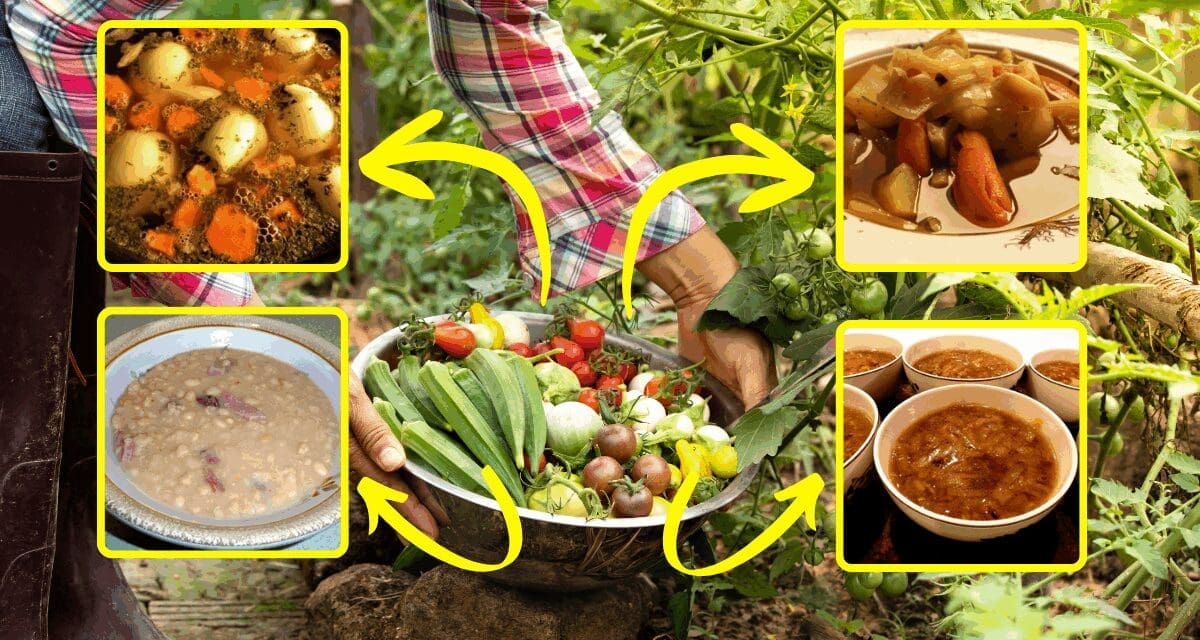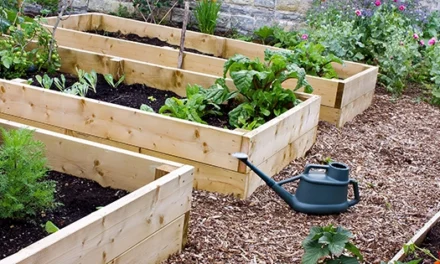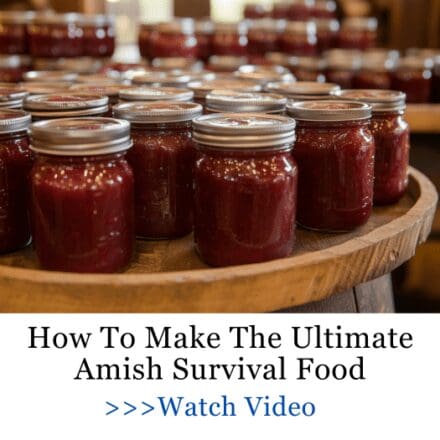Harvest season always brings an abundance of vegetables. Many continue to thrive into winter including many root vegetables like carrots, onions, turnips and parsnips, and brassicas like broccoli, cabbage, kale and cauliflower. Others like tomatoes, peppers and peas need to be harvested earlier. The result is a cornucopia of fruits and vegetables and all of them lead to some traditional, healthy and hearty soups.
Some of these soups can be made in a crockpot or a cast iron pot or Dutch Oven. All of them are not only filled with flavor but are highly nutritious. In fact, autumn into winter is the ideal time for soups on cold and chilly late season days and nights.
We’re going to cover hearty soups that make the most of your harvest.
All of the soups have a base made from a broth or stock.
Onion Soup
Onions just keep going and going and going in the garden. In fact, letting an onion plant overwinter will result in monster onions next season. The onion bulb survives in freezing ground and in the spring new shoots will emerge as the onion continues to grow. The good news about all of that is you can pretty much harvest onions year round if you plant enough of them. If that’s the case you’re ready to make some French onion soup.
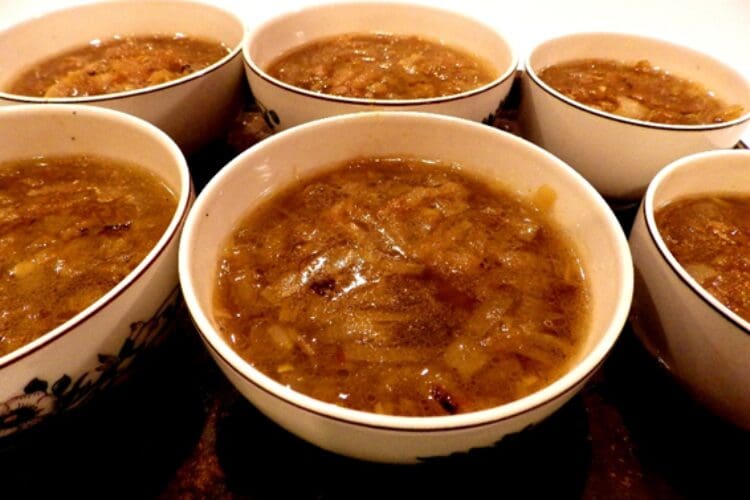
Onion Soup Recipe:
(Makes 6 servings)
Ingredients:
- 8 cups of beef broth
- 12 large onions
- 4 Tbsps. Butter or olive oil
- 2 cups of grated gruyere cheese
Directions:
- Peel and slice the onions into rings.

- In a large cast iron pot, melt the butter of add the olive oil.
- Add all of the onions to the pot and stir from time to time. The goal here is to caramelize the onions. If you want to accelerate the caramelization, add 2 tbsps. Of sugar to the onion and stir to coat. Keep tossing the onions so they can all get exposed to the heat at the bottom of the pot and turn a deep brown.
- Once the onions are caramelized add the beef broth. Lower to a simmer and simmer for 10 minutes to meld the flavors.
- Ladle the onions and broth into 6 bowls and top with grated gruyere cheese. You can substitute any other white cheese that you like.
- Bake for 20 minutes in a 325º F oven (163º C.) until the tops are browned.
- Let rest for 5 minutes (the cheese will be piping hot) and dig in.
Winter Root Soup
This gets back to those winter roots we mentioned including carrots, potatoes, onions and parsnips. Long after most vegetable plants have found their way to the compost heap, winter roots can survive into late fall and early winter or even later. It’s a classic pioneer recipe when grocery stores didn’t exist and the summer harvest in storage was becoming more limited.

Winter Root Soup Recipe
(Makes 4 servings)
Ingredients:
- 6 cups of beef broth or chicken broth
- 4 carrots cut into long slices
- 4 potatoes peeled and cut into chunks.
- 2 large onions cut into large pieces.
- 2 parsnips peeled and cut into 2-inch lengths.
- 2 Tbsps. Of butter or olive oil
Directions:
- Cut up all the vegetables as directed in the ingredients section.
- In a large cast iron pot over medium heat, melt the butter or add the olive oil.
- Add the onions and carrots to the pot and stir until lightly caramelized.
- Add the potatoes and parsnips and stir occasionally for about 5 minutes.
- Add the broth and bring to a boil and then reduce to a simmer and simmer for 20 minutes.
- Ladle into bowls and serve with bread.
- If you want to turn this root soup into a powerful cold-season tonic, stir in a teaspoon of powdered reishi, chaga, or lion’s mane while it simmers. These adaoptogenic mushrooms have long been prized for their ability to strengthen the immune system, steady energy levels, and support the body’s natural defenses when the weather turns cold. Reishi and chaga strengthen the immune system, help your body fight off cold-season illnesses, and steady your energy when the days are short and gray. Lion’s mane supports brain and nerve health, keeping your focus sharp even through the toughest winter chores
The problem is that buying each one individually can get expensive fast. Reishi alone can cost $25–$30, and by the time you add the rest, you could easily be spending over $250. I know, times are though, and every dollar counts these days, so this is probably not what you want to hear right now.
So I want to share with you a solution that makes it way more simple and affordable. I discovered this bundle some time ago that gives you all four adaptogenic mushrooms in highly concentrated form. Just 1–2 drops in soups, teas, or coffee is enough to get a full dose of immune-boosting, stress-fighting, and focus-enhancing benefits. That means one single bundle will last you months with daily use, saving you hundreds compared to buying each mushroom separately, while giving you an effortless, long-term way to supercharge your health without running out or overspending. Here is the link of where I got it from (but hurry up, because supplies are limited and these bundles tend to sell out quickly..)
Skillagalee (Perpetual Soup)
This is another pioneer recipe popular on cattle drives, wagon trains and during the Yukon Gold Rush. In some respects, it’s an everything soup. The camp cook put everything he could find to make this soup resulting in a medley of vegetables. It was cooked in large cast iron kettles over an open fire and was constantly replenished with stock and more vegetables. That resulted in the name “Perpetual Soup.”
>>>Forgotten, Long-Lasting Foods That Don’t Need Refrigeration <<<
This soup is ideal in a crockpot and if you keep it going with more stock or broth and vegetables you can eat it for days. Meat is an option and beef bones, or chicken bones were often added by camp cooks to enrich the stock. When salt was added the stock became a broth and it kept the cowboy and gold miners from harassing the cook when they came into camp hungry. A quick dip of a tin cup into the soup and everyone had an instant meal.
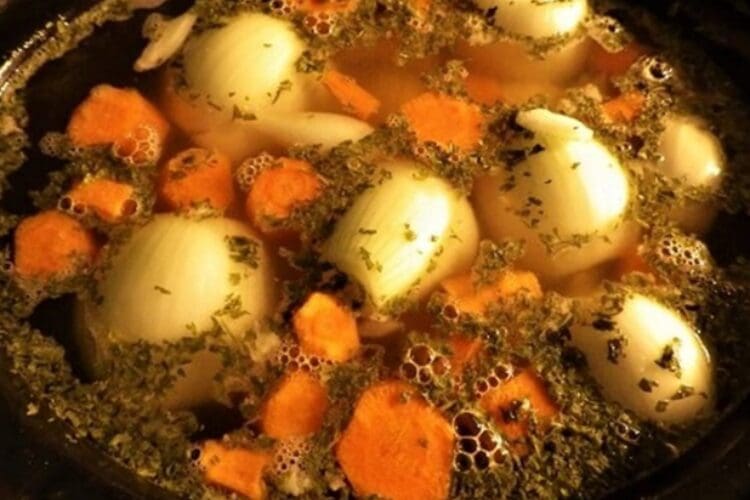
Skillagalee (Perpetual Soup)
(Servings vary)
Ingredients:
- 10 cups of chicken stock (or enough to fill the crockpot halfway)
- Salt
- Vegetable Possibilities:
- Carrots
- Onions
- Potatoes
- Turnips
- Parsnips
- Kale
- Broccoli
- Cauliflower
- Spinach
- (Or whatever you have on hand from your harvest)
Directions:
- Add the stock to the crockpot and turn the heat on high.
- Cut the vegetables into spoon sized pieces. Think in terms of getting 3 to 4 vegetable pieces on a spoon.
- Add the vegetables to the crockpot and cook on high for 2 hours.
- Season with salt to taste.
- Reduce the heat to medium and ladle into bowls or dip a cup.
- If you want to keep it going, add more stock and vegetables and return the heat to high for 1 to 2 hours depending on the types of vegetables you added (potatoes and carrots take some time).
- If you want to keep it warm overnight, turn the heat to medium and in the morning turn it back to high for ½ and hour.
Depression Era Bean Soup
Bean soups were very popular during the Depression of the 1930’s. The simple reason was that beans were often the only source of protein. Meats of all types were both expensive and hard to find. Beans were inexpensive, stored easily for years and made a nutritious meal. They were also easy to grow in backyard gardens and were prolific. If you have beans growing in your garden and a large harvest you should definitely consider this hearty and healthy bean soup recipe.
The beans you use are up to you. If there still fresh on the vine you can shell them and your cooking time will be less. If the beans have dried and are hard you’ll need to soak them overnight to soften them up. You can use any bean variety, and many people combine different beans.

Depression Era Bean Soup
(Makes 8 servings)
Ingredients:
- 9 cups of chicken broth
- 8 cups of beans (You can either use a single bean you harvested or a combination of beans if you harvested more than one variety. Remember to soak them overnight if they have dried)
- 1 clove of garlic diced
- (OPTIONS) You could add a diced carrot and diced onion if you want to expand the flavor)
Directions:
- Soak the beans in water overnight if they are dried.
- Add the chicken broth to a large cast iron pot and bring to a boil.
- Add the beans to the broth and reduce the heat to medium.
- Add optional ingredients like diced carrot or onion.
- Add the diced garlic which is also optional.
- If you want, you can slightly mash some of the beans in the pot to make the soup creamier.
- After 1 hour on medium heat ladle and serve
Vegetarian Ramen
Ramen noodles are cheap and can add a great texture and taste to a vegetable based soup. The noodles even come with their own flavor packet. This is a soup that’s popular with kids and it’s very easy to make. Any medley of vegetables you harvested will work so it gives you a lot of flexibility.

Ingredients:
- 4 packages of Ramen noodles
- 8 cups of water
- 6 cups of Assorted chopped and diced vegetables including:
- Carrots
- Onions
- Kale
- Spinach
- Bell pepper
- Broccoli
Directions:
- Add the water to a large pot and open the Ramen flavor packets and stir into the pot.
- Chop and dice the vegetables.
- Bring the pot of water to a boil and add the vegetables and cook for 10 to 15 minutes.
- Add the Ramen noodles to the boiling water and occasionally pull the noodles apart. Cook for 10 minutes or until noodles are tender.
- Ladle into bowls and serve with soy sauce on the side.
There’s No Limit
Once you’ve mastered some of these recipes you’ll find there’s no limit to the types and variety of soups you can make. It all gets down to personal taste and what you brought into the kitchen from your harvest.
In the meantime…
When Pharmacies Run Dry… This Is What You’ll Wish You Had
You can swap out your food. You can choose fluoride-free toothpaste. You can try to eat organic. But as long as you’re still dependent on over-the-counter pills, creams, and prescription drugs, you’re not safe.
The truth is, every shelf in every store is loaded with chemicals. Even the ones labeled “natural.” And if we ever reach a point where the system cracks — if supply chains freeze, shelves go empty, or drug ingredients get restricted — you’ll have nothing.
That’s when this book becomes your lifeline.
The Forgotten Home Apothecary is the ultimate guide to replacing chemical-laced, pharma-dependent products with powerful, time-tested remedies you can make at home.
You’ll learn exactly how to make your own tinctures, capsules, oils, teas, salves, elixirs, syrups, and poultices from plants you can find growing around you — or already in your kitchen.
These are not “Pinterest cures” or folk tales. These are battle-tested remedies used by herbalists, survivalists, and those who want real protection when nothing else is available.
Inside, you’ll discover powerful remedies like:
 Memory Elixir – made with rosemary to help restore clarity, focus, and short-term memory
Memory Elixir – made with rosemary to help restore clarity, focus, and short-term memory
 Painkiller in a Jar – crafted from wild lettuce, known as “nature’s opium” but legal, safe, and non-addictive
Painkiller in a Jar – crafted from wild lettuce, known as “nature’s opium” but legal, safe, and non-addictive
 Nature’s Amoxicillin – a plant-based antibacterial formula to help fight infections and boost immunity
Nature’s Amoxicillin – a plant-based antibacterial formula to help fight infections and boost immunity
 Medicinal Herbal Smoking Blend – designed to clear lungs and soothe inflammation with mullein and other wild herbs
Medicinal Herbal Smoking Blend – designed to clear lungs and soothe inflammation with mullein and other wild herbs
 Heavy Metal Detoxifier – flushes out mercury, aluminum, and lead from your bloodstream using safe, herbal chelators
Heavy Metal Detoxifier – flushes out mercury, aluminum, and lead from your bloodstream using safe, herbal chelators
 Herbal Parasite Flush – a powerful three-ingredient recipe to eliminate worms and cleanse your gut
Herbal Parasite Flush – a powerful three-ingredient recipe to eliminate worms and cleanse your gut
 The Backyard Aspirin – learn to use willow bark like early apothecaries did — it works like real aspirin, without the synthetic junk.
The Backyard Aspirin – learn to use willow bark like early apothecaries did — it works like real aspirin, without the synthetic junk.
And that’s just the beginning.
This book may be the only thing standing between you and full pharmaceutical dependence in a time of crisis.
 Click here to get The Forgotten Home Apothecary before it’s gone. Limited edition. Real remedies. No chemicals.
Click here to get The Forgotten Home Apothecary before it’s gone. Limited edition. Real remedies. No chemicals.
50+ Items You Should Stockpile Before The Next Great Depression (Video)

